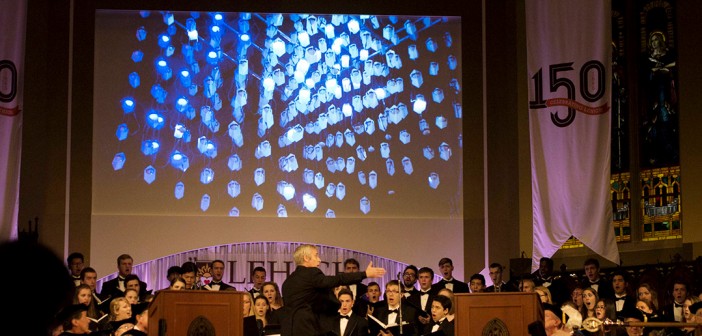As the beginning of the semester marked the conclusion of most Mountaintop projects, “The Founder’s Day Experience,” was nearing its Oct. 2 deadline.
To honor the university’s sesquicentennial celebration and the installation of John D. Simon as Lehigh’s 14th president, Ronald J. Ulrich, a professor of music, and Choir Director Steven Sametz, wanted a memorable performance to accompany the piece Sametz was asked to compose.
The result was a light sculpture, made of 340 crystal-encased LED light bulbs, 10 feet long on each side and suspended with an aircraft cable and aluminum pipes from the Packer Memorial Church ceiling. What further contributed to the structure’s novelty was the audience interaction it entailed. Via their smartphones, spectators were able to access a data-collecting website which accordingly altered the colors of the chandelier and affected the choir’s sound.
Trevor Davis, ‘15, and Geordan Johnson, ‘15, became aware of the project through their involvement in choir and were two of the seven members recruited for the Mountaintop team. Hannah Han, ‘15, an architecture and art major, helped envision the shape of the individual crystals and provided feedback on the group’s ideas regarding design.
“It was a unique project because there was a big technology side to it which art students typically don’t get themselves involved with,” Han said.
According to Davis, a physics and math major minoring in astronomy, Sametz wanted to involve students from a variety of disciplines to embody the whole university working together.
The eruption of stellar system Eta Carinae, a major astronomical event that took place around 150 years ago — around the same time Lehigh was created — was the source of Sametz’s inspiration.
“The idea was to analyze data from Eta Carinae, pick out patterns and create an algorithm from those patterns to create music,” Davis said, who held the role of astrophysicist. “My job was to come up with the algorithms and computer coding to output a music file, then Sametz used that as a base for the composition that he wrote and arranged it around using the same form and notes.”
Each member’s diverse skill sets and ideas contributed to the all-around completion of the project.
“We would all have separate tasks to work on and then have a group discussion on what we want to accomplish,” Davis said. “Sametz was our faculty advisor, but the technical aspect was all of us.”
Despite having a pool of majors ranging from engineering to psychology, the nature of the design came with unavoidable obstacles which demanded time and patience. According to Johnson, a computer science major, the initial challenge was coming up with the idea. Johnson worked alongside Davis to use microdata and the programming language Python to create a minifile to use as input for the organs, so that they would play without having someone there.
“Seeing what was feasible financially, we wanted something that was going to be large and hang from the ceiling and be interactive,” Johnson said. “Trying to find unique ways to integrate everything was difficult.”
Holograms and laser projectors were among the initial proposed ideas in the group. However, the price of creating the hologram and intricacy of arranging the crystals so that each would be targeted by the projector, made the LED bulbs the best option.
“There were a lot of unseen roadblocks,” Johnson said. “Nothing like this was done before and we were very hesitant.”
Despite experiencing technical difficulties the night before during the dress rehearsal, Davis said that having the performance come together functionally in the last minute was personally his most rewarding experience.
“It was a good example of how people could collaborate on one thing and have so many parts and instruments come together to create this one and done type moment,” he said. “Unlike other projects, we actually had a strict deadline to produce something and have it work for such a momentous occasion. It was a very big deal for the university that we get it accomplished.”
Although the sculpture is currently still in the chapel and may be used for the Christmas Vespers concert, its exact future plans remain uncertain.






Comment policy
Comments posted to The Brown and White website are reviewed by a moderator before being approved. Incendiary speech or harassing language, including comments targeted at individuals, may be deemed unacceptable and not published. Spam and other soliciting will also be declined.
The Brown and White also reserves the right to not publish entirely anonymous comments.